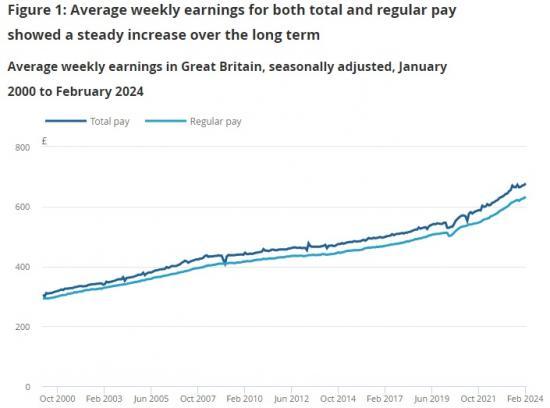Average Weekly Earnings In Great Britain - April 2024
16th April 2024

The following information is for the period from December 2023 to February 2024.
Annual growth in regular earnings (excluding bonuses) was 6.0%, and annual growth in employees' average total earnings (including bonuses) was 5.6%.
Annual growth in real terms (adjusted for inflation using the Consumer Prices Index including owner occupiers' housing costs (CPIH)) for regular pay was 1.9%, and for total pay was 1.6%.
Annual average regular earnings growth for the public sector remains relatively strong at 6.1%; for the private sector this was 6.0%, with growth last lower than this in April to June 2022 (5.4%).
The manufacturing sector saw the largest annual regular growth rate at 6.9%, closely followed by the finance and business services sector at 6.8%.
Average weekly earnings (AWE) were estimated at £677 for total earnings and £633 for regular earnings in February 2024. Figure 1 shows that average weekly earnings have steadily increased over the long term.
The annual growth for regular earnings (excluding bonuses) was 6.0% in December 2023 to February 2024. Annual growth in employees' average total earnings (including bonuses) was 5.6% in December 2023 to February 2024.
Our headline growth rate is the annual change between the latest three-month period and the same three months one year ago. This means that, in some areas, the latest months are currently compared with low base periods before the high pay rises were given over the last year, which are partly a reaction to high inflation and the cost-of-living crisis. Looking at annualised growth rates over the short term can help assess more recent earnings trends. If we compare the latest three months with the three months that preceded them, and then annualise this growth rate, nominal regular average weekly earnings grew by 4.8%.
This shows that if we look at growth over the short term, it is not as strong as when comparing over a full 12-month period when regular earnings grew by 6.0%. Note that the three-month annualised growth rate has increased in recent periods but still remains below the full 12-month comparison. We will continue to publish our headline estimate using the annual year-on-year growth rate, but this provides further context on shorter-term changes for users.
In real terms (adjusted for inflation using the Consumer Prices Index including owner occupiers' housing costs (CPIH)), total real pay was 1.6% in December 2023 to February 2024. It was last higher in July to September 2021, when it was 3.1%. Regular real pay was 1.9%; it was last higher in July to September 2021, when it was 2.2%.
As inflation has reduced over the past few months, we are now seeing real growth rates increase on the year. Figure 3 shows a comparison of monthly real total and regular pay growth rates and monthly inflation. For December 2023 to February 2024, CPIH was an average of 4.1%.
Our headline measure of inflation is CPIH. However, we also publish our supplementary Real average weekly earnings using consumer price inflation (CPI) dataset, excluding owner occupiers' housing costs. Using CPI real earnings, in December 2023 to February 2024, total pay was 1.8%. Growth was last higher in July to September 2021, when it was 3.0%. Regular pay was 2.1%; growth was last higher in July to September 2021, when it was 2.2%.
The Earnings and employment from Pay As You Earn Real Time Information, UK bulletin also provides additional insights into the estimate of growth in median and mean pay, and the two data sources generally trend well for mean total pay. A more timely estimate of median pay is also provided but is subject to revisions.
However, there will be differences between the two data sources because of timing and definitional differences, as set out in our Comparison of labour market data sources methodology.
Read the full ONS report HERE
